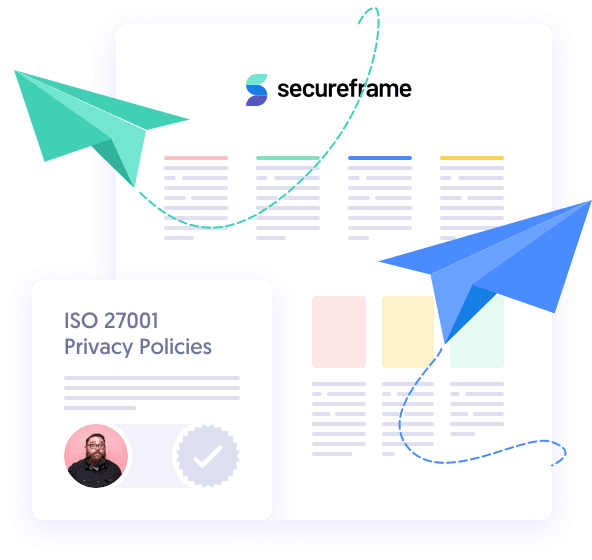
The 10 Most Important Cybersecurity Metrics & KPIs for CISOs to Track
Emily Bonnie
Senior Content Marketing Manager
Anna Fitzgerald
Senior Content Marketing Manager
Number of intrusion attempts, average security incident severity level, virus and malware monitoring, mean-time metrics, corporate network data volume…. Security leaders are inundated with metrics to track.
At best, tracking too many metrics is a distraction that dilutes your focus. At worst, they can paint a misleading picture of your cybersecurity program performance and affect your ability to make well-informed business decisions. Too. many metrics can also confuse and overwhelm your execs and board.
The most effective CISOs, CIOs, and IT security leaders are able to separate signal from noise by zeroing in on the right key performance indicators and monitoring them obsessively. To that end, we’ve honed a list of 10 metrics and KPIs that give CISOs and security teams actionable insights into their cybersecurity initiatives. You should choose only the most relevant of these to your situation.
Cybersecurity metrics vs KPIs
A quick sidebar before we dive into the list of metrics and KPIs — what’s the difference between cybersecurity metrics and KPIs?
KPIs measure performance around strategic business goals. They help CISOs and other cybersecurity leaders understand what aspects of the security program have been implemented successfully and what areas need further attention so they can make informed cybersecurity strategy decisions.
Cybersecurity metrics provide quantitative insights into how an organization’s security controls and programs are performing.
KPIs should be actionable and goal-oriented. Here’s an example of a cybersecurity KPI vs metric:
- Cybersecurity KPI: Measure security training effectiveness through an average employee security health score
- Cybersecurity metrics: Security awareness training completion rates, average quiz scores, phishing test success rates, policy acknowledgment rates
The right cybersecurity metrics and KPIs are essential for measuring performance and responding to risk more effectively and efficiently. They provide better visibility into how cybersecurity initiatives add value across the business. And they help CISOs and CIOs demonstrate to company leadership and the board of directors what they’ve done to protect data integrity and security across the organization.
10 Key cybersecurity metrics to track in 2023
These ten metrics and KPIs will help you measure the effectiveness of your information security controls and initiatives. With these metrics, you’ll be well-equipped to identify and mitigate risk and protect your information assets.

Threat detection and incident response KPIs
1. Mean Time to Detect (MTTD): The faster your team detects a security incident, the faster it can respond. This metric measures the average amount of time between when an incident occurs and when it’s detected.
2. Mean Time to Response (MTTR): The faster your team can respond to an incident, the better it can contain and limit its impact. Measuring the average time it takes for your team to neutralize a threat and regain control of any compromised systems can help you minimize potential damage and optimize your efforts.
3. Mean Time to Contain (MTTC): How long does it take your team to secure all compromised endpoints and attack vectors? Tracking this metric can demonstrate the efficiency and effectiveness of your team in reducing the impact of a security incident or cyberattack.
Focus on MTTR and if you think it makes sense later include MTTD.
Performance KPIs
4. Average delay and downtime: This metric tracks the average time systems are non-operational, whether for repair, corrective and preventive maintenance, or system failures. According to Gartner, a single minute of downtime costs companies an average of $5,600. The best way to mitigate downtime risks and minimize costs is to track and identify trends.
5. Average cost per security incident: How much does it cost to respond to and resolve an attack? Take into account factors like investigation and remediation costs, as well as lost employee productivity and overtime. Be very careful to make sure that your KPI here is well informed, backed up by good data. If you make it up and you can’t explain it you will lose credibility.
6. Number of systems with known vulnerabilities or high number of misconfigurations: A keen understanding of vulnerabilities within your environment is essential to identifying and mitigating threats. How many vulnerabilities are present in your system, and which are critical vulnerabilities? Reports from regular vulnerability scans, penetration tests, and patch releases can help demonstrate trends in the number of exposed assets and prove the effectiveness of your vulnerability management.
Preparedness KPIs
7. Security training effectiveness: Employees who know how to recognize and respond to potential cybersecurity threats are essential to preventing a breach. How effective is your security awareness training in reducing human risk? These metrics will help you understand what’s working and identify opportunities for improvement.
- Percentage of employees who completed security awareness training in the last 12 months and quiz results
- Test phishing attack success
8. Vendor security risk and compliance reports; security ratings: Nearly 60% of companies believe they have suffered a data breach due to vendor access. Vendor security ratings provide a high-level overview of the strength of an organization’s security posture. Tracking security ratings for the vendors you partner with can be an effective way to monitor and limit your risk exposure. Supply chain and vendors are critical many have less than ideal data security practices which is a direct and important impact to ANY security program.
9. Patching cadence (and vendor patching cadence): How often does your organization review systems, networks, devices, and applications for updates that patch security vulnerabilities? A well-established patching process can help you track, monitor, prioritize, and limit vulnerabilities. If you don’t patch, you are breach eligible.
10. Access management: A strong IAM strategy impacts multiple aspects of an organization, from strengthening data security and confidentiality to reducing workloads for IT and information security teams. By monitoring access controls and limiting access to the minimum necessary, you can demonstrate to stakeholders that you’ve dramatically reduced the risk of unauthorized access.
- Number of users with superuser access level
- Average time to deactivate former employee credentials
- Third-party access review cadence
Internal security audit and compliance reports should also be reviewed periodically to update core elements of your information security posture such as your current threat landscape, risk management strategy, third-party risk exposure, remediation plan, and any internal performance benchmarks.
Recommended reading

What Is Compliance Risk and How To Minimize It
Executive reporting: Making cybersecurity metrics meaningful
Tracking the metrics that matter is just one piece of the puzzle — it’s making those metrics matter to other key stakeholders that’s essential.
You might have 10 or 15 metrics (or more) that you track for your own benefit, but as CISO it’s your job to take those metrics and tell a story that’s tailored to your specific audience and explains why they should care. When you present to the executive team you might share the top six or seven metrics, but when you report to the board of directors you might highlight just two or three.
What does your audience care about, and how can you show the impact of your security and compliance activities on those key business goals?
The board cares about revenue and profits, so use your reporting metrics to demonstrate and quantify how your efforts move that needle. Maybe you achieved new security certifications or implemented a faster RFPs and security questionnaires process and that positively impacted the number of customers you acquired or average deal size.
When sharing quarterly results with the executive team, you could present a series of KPIs that are aggregate scores of various security and compliance metrics: a vulnerability risk score, third-party risk score, security compliance score, security awareness score — then demonstrate how those aggregate scores are trending over time and how they affect the overall health of the organization.
Whatever you choose to present, it must be tailored to your organization and your audience. As CISO, it’s critical that you’re able to translate your metrics into a meaningful narrative that explains how security, privacy, and compliance programs add value across the business.

Internal Security Audit Checklist
Use this comprehensive checklist to assess your security practices and identify areas for improvement.
Choosing the right cybersecurity metrics for your business
As with almost everything in the world of information security, there is no one-size-fits-all answer. While the metrics listed above will give you essential insights into how your cybersecurity program is performing over time, the exact metrics you choose to track will depend on your specific industry, regulations, customer requirements, and cybersecurity risk profile.
An all-in-one security and privacy automation platform like Secureframe makes it easy to get meaningful insights into the performance metrics that matter most to you. Continuous monitoring across your tech stack offers complete visibility and actionable insights into your data security and privacy posture, and real-time dashboards give you a clear picture of your compliance status at a glance.
Learn more about Secureframe’s powerful reporting capabilities, or see the platform in action by requesting a demo.
Become a security expert.
Get the latest articles on startup security and compliance best practices delivered straight to your inbox.


Emily Bonnie
Senior Content Marketing Manager
Emily Bonnie is a seasoned digital marketing strategist with over ten years of experience creating content that attracts, engages, and converts for leading SaaS companies. At Secureframe, she helps demystify complex governance, risk, and compliance (GRC) topics, turning technical frameworks and regulations into accessible, actionable guidance. Her work aims to empower organizations of all sizes to strengthen their security posture, streamline compliance, and build lasting trust with customers.

Anna Fitzgerald
Senior Content Marketing Manager
Anna Fitzgerald is a digital and product marketing professional with nearly a decade of experience delivering high-quality content across highly regulated and technical industries, including healthcare, web development, and cybersecurity compliance. At Secureframe, she specializes in translating complex regulatory frameworks—such as CMMC, FedRAMP, NIST, and SOC 2—into practical resources that help organizations of all sizes and maturity levels meet evolving compliance requirements and improve their overall risk management strategy.